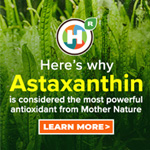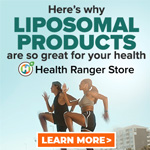
Research Links Plastics Containing Bisphenol A to Heart Disease and Diabetes
Tuesday, September 16, 2008 by: Sherry Baker, Health Sciences Editor
Tags: Bisphenol A, health news, Natural News
- Pfizer faces legal backlash: Texas, Kansas, and more states begin to challenge Prep Act Immunity Shield
- Maple syrup: Nature's golden superfood and its sweet health benefits
- Manufacturing surge under Trump sparks optimism amid concerns over economic strains
- Florida sky mystery: Toxic heavy metals and bioengineered particles found in air and food samples
- Possible biosignatures detected on Exoplanet K2-18b, raising hopes for alien life
- Aerosolized bioweapons? Strange “diploid biomasses” falling out of the sky in Florida captured under the microscope
- Omega-3s: a powerful ally in the fight against chronic inflammation
- U.S. demands U.K. protect FREE SPEECH, repeal hate speech authoritarianism, in latest trade deal negotiations
- HHS Secretary Kennedy will likely investigate the following environmental exposures as CAUSES OF AUTISM and brain damage in children
- Russia escalates censorship war, targets over 200 VPN apps amid Google resistance
- Analysis: The coming economic collapse, a mass uprising and Trump's three secret weapons to halt the growing revolt
- Mike Adams releases country western hit single: Goin’ Back in Time is Comin’ Home
- Trump's bold trade overhaul reaches a crossroads with Italy, as "fair deals" promise sparks global attention
- Majority of Americans now favor mass deportation of illegal immigrants, polls show shift in public sentiment
- TAKE IT DOWN Act advances in Congress amid free speech concerns
- Kava: The Pacific's healing wonder
- Kiss Your Genetic Privacy Good-Bye! 23andMe Gets Green Light to Sell Your Intimate Genetic Details to Anyone They Want
- M.W. Walbert’s “The Coming Battle” traces the evolution of money power in America
- Aerosolized bioweapons? Strange “diploid biomasses” falling out of the sky in Florida captured under the microscope
- Analysis: The coming economic collapse, a mass uprising and Trump's three secret weapons to halt the growing revolt
- Widespread social and economic unrest: Steve Quayle issues urgent financial warning of imminent asset collapse in new interview with Mike Adams
- TAKE IT DOWN Act advances in Congress amid free speech concerns
- Israeli lobbyists boast of controlling US national security policy in leaked AIPAC audio
- Kiss Your Genetic Privacy Good-Bye! 23andMe Gets Green Light to Sell Your Intimate Genetic Details to Anyone They Want
- Mike Adams releases country western hit single: Goin’ Back in Time is Comin’ Home
- U.S. lawmakers investigate Meta over alleged China collaboration
- CLOT SHOT PLANDEMIC UNFOLDING: Fibrous, rubbery clots caused by covid injections have prion-like seeding activity
- Fauci is back in the limelight, and he’s busy promoting a future COVID or FLU pandemic
- Defunding DEADLY mRNA jabs: Government funding for mRNA technology being scrutinized and sidelined until proven "safe and effective" for real
- Russia escalates censorship war, targets over 200 VPN apps amid Google resistance
- Curcumin’s ancient healing power supercharges muscle recovery, and its effects are compounded with anti-inflammatory foods and supplements
- I Want My Bailout Money – new song and music video released by Mike Adams
- I Want My Bailout Money – new song released by Mike Adams
- Government waste exposed: Hegseth supports Musk’s demand for accountability from federal workers
- U.S. approves new Russian ambassador as diplomatic thaw continues
- Federal employees whine over DOGE's new directive requiring them to do a 5-point summary of weekly accomplishments
- Newly released JFK files reveal Pentagon's role in creating Lyme disease and covid in the same lab
- Analysis: The coming economic collapse, a mass uprising and Trump's three secret weapons to halt the growing revolt
- Aerosolized bioweapons? Strange “diploid biomasses” falling out of the sky in Florida captured under the microscope
- Kiss Your Genetic Privacy Good-Bye! 23andMe Gets Green Light to Sell Your Intimate Genetic Details to Anyone They Want
- Mike Adams releases country western hit single: Goin’ Back in Time is Comin’ Home
- European Court of Justice: Healthcare professionals who promoted or administered COVID-19 vaccines are CRIMINALLY LIABLE for any harm caused
- Widespread social and economic unrest: Steve Quayle issues urgent financial warning of imminent asset collapse in new interview with Mike Adams
- Federal employees whine over DOGE's new directive requiring them to do a 5-point summary of weekly accomplishments
- U.S. approves new Russian ambassador as diplomatic thaw continues
- CLOT SHOT PLANDEMIC UNFOLDING: Fibrous, rubbery clots caused by covid injections have prion-like seeding activity
- Government waste exposed: Hegseth supports Musk’s demand for accountability from federal workers
- I Want My Bailout Money – new song and music video released by Mike Adams
- I Want My Bailout Money – new song released by Mike Adams
- Fauci is back in the limelight, and he’s busy promoting a future COVID or FLU pandemic
- Defunding DEADLY mRNA jabs: Government funding for mRNA technology being scrutinized and sidelined until proven "safe and effective" for real
- Trump administration poised to overhaul crypto regulations with new SEC leadership
- Now you can HEAR chemistry: Health Ranger translates molecules into music in stunning video demonstration that will blow your mind (and your ears)
- South Carolina Congressman proposes new $250 bill and wants Trump on the front
- Red Cross issues warning to stop blood plasma donations from vaccinated people
- Scientists confirm: GENIUS brain function can be spontaneously unleashed in humans without any apparent cause
- EPA advisor admits the agency is funneling billions to climate groups ahead of Trump’s return to White House
- HYSSOP: What research reveals about the health benefits of this ancient holy herb
- Two containers with completed ballots fall out of truck in Florida
- Newly released JFK files reveal Pentagon's role in creating Lyme disease and covid in the same lab
- Mike Adams releases country western hit single: Goin’ Back in Time is Comin’ Home
- Global leaders unite to clamp down on “misinformation” with UN-backed Cascais Declaration
- BREAKING: 2025 NDAA authorizes mandatory military draft of WOMEN across America… as Pentagon pursues global NUCLEAR war with both Russia and China at the same time
- I Want My Bailout Money – new song released by Mike Adams
- Michael Yon warns of a ZIONIST TAKEOVER in Trump’s second administration
- The Health Ranger releases “Vaccine Zombie” song and music video, using AI-animated zombies for the music video
- Ozempic and Wegovy weight loss drugs are injectable LIZARD VENOM PEPTIDES that may unleash a devastating wave of organ failure… side effects align with symptoms of SNAKE BITES
- BOMBSHELL: DNA testing kits are a SCAM to develop ethnic-specific bioweapons
- Israeli soldiers accused of even more torture and abuse in the West Bank
- These 13 countries just signed an agreement to engineer a global FAMINE by destroying food supply
- RFK Jr. clears key hurdle: Sen. Susan Collins backs controversial HHS nominee, signaling a new era for health policy
- NASA admits that climate change occurs because of changes in Earth’s solar orbit, and NOT because of SUVs and fossil fuels
Previous studies have found BPA causes precancerous conditions, kidney and developmental problems in animals. But new research, published in the September 17th edition of the Journal of the American Medical Association (JAMA), shows that humans could be walking time bombs of health problems due to "normal" exposures to BPA.
British researcher David Melzer, M.B., Ph.D., of Peninsula Medical School in Exeter, and colleagues measured the BPA found in the urine of 1,455 adults between the ages of 18 and 74 years, using data from the National Health and Nutrition Examination Survey (NHANES) which was gathered in 2003 and 2004. Then they looked at the health status of these people whom the scientists note in the JAMA report are "representative of the adult U.S. population".
The results? Dr. Melzer and his team found that average BPA concentrations, adjusted for age and sex, were higher in those diagnosed with cardiovascular diseases and diabetes. In fact, even a slightly raised BPA concentration was associated with a 39 percent increased risk of having cardiovascular disease (angina, coronary heart disease, or heart attack combined) and diabetes.
Those with the highest BPA concentration had nearly three times the odds of heart disease and 2.4 times the risk of diabetes when compared with those with the lowest levels. What's more, higher levels of BPA concentrations were also associated with abnormally elevated levels of three liver enzymes.
"These findings add to the evidence suggesting adverse effects of low-dose BPA in animals. Independent replication and follow-up studies are needed to confirm these findings and to provide evidence on whether the associations are causal," the authors said in a statement to the media. "Given the substantial negative effects on adult health that may be associated with increased BPA concentrations and also given the potential for reducing human exposure, our findings deserve scientific follow-up."
But is it too little too late? And is anyone in Washington going to listen? They certainly haven't in the past.
There was concern earlier this year that huge numbers of children were being exposed to BPA because it is known to leach out of hard polycarbonate plastics that are used widely in baby bottles, sippy cups and water bottles. The Department of Health and Human Services' National Toxicology Program released a report on the safety of the chemical and warned BPA could cause health and developmental problems.
"Because these effects in animals occur at bisphenol A exposure levels similar to those experienced by humans, the possibility that bisphenol A may alter human development cannot be dismissed," the report concluded.
Predictably, this and other warnings about BPA, have been hotly contested by plastic industry leaders. "Much like the pharmaceutical industry, the plastics industry wants consumers to believe their chemicals are so safe that babies can drink them with impunity," says Mike Adams, a consumer health advocate and editor of NaturalNews.com. "This flies in the face of common sense, and this new research is demonstrating why we need to be so vigilant about protecting ourselves and our children from plastic packaging."
Last spring, consumers bombarded the U.S. Food and Drug Administration (FDA) with demands to know if BPA-containing baby and food products are safe. The government agency claimed to have investigated the matter. But, despite dozens of animal studies showing the chemical is a danger to health, the FDA ruled in August there was insufficient evidence to support banning BPA from baby and food products.
However, a new FDA hearing is set to start today, September 16, in Rockville, Maryland, to discuss the BPA issue once again. In fact, JAMA issued a press release saying the prestigious medical journal is releasing the findings of the new human study a day early to coincide with the FDA hearing.
Clearly, mainstream medicine is now recognizing that the chemical contaminant is a real health concern.
In the JAMA editorial that accompanies the new BPA study, Frederick S. von Saal, Ph.D., of the University of Missouri, Columbia, and John Peterson Myers, Ph.D., of Environmental Health Sciences, Charlottesville, Va., point out that BPA production has reached about 7 billion pounds per year and the chemical has caused massive planetary contamination. Why? Consider the fact that products containing BPA, like microwavable food containers, often end up in landfills and dumped into water ecosystem. Already, Canada has declared the chemical to be a major worldwide pollutant.
"The good news is that government action to reduce exposures may offer an effective intervention for improving health and reducing the burden of some of the most consequential human health problems. Thus, even while awaiting confirmation of the findings of Lang et al, decreasing exposure to BPA and developing alternatives to its use are the logical next steps to minimize risk to public health," Dr. von Saal and Dr. Myers state in the editorial.
Considering U.S. citizens have been waiting for years for the government to even acknowledge that BPA is a health hazard, it makes little sense to rely on the FDA to to protect us from the chemical. Instead, there are ways to take control of your and your family's exposure to BPA.
Avoid baby formula as much as possible.
According to the Environmental Working Group (EWG) (http://www.ewg.org/chemindex/chemicals/23297) , a non-profit organization comprised of scientists, engineers, policy experts, lawyers and computer programmers who have been in the forefront of pointing out the potential health and environmental hazards of BPA, all U.S. manufacturers of formula use a BPA containing lining on the metal part of their containers. Opt for breastfeeding exclusively if possible, or use a dry formula that is mixed with filtered water.
Eat fresh, not canned, food.
The EWG has found that food and drink cans are lined with BPA-laden plastic. Canned soups and spaghettis have the highest levels.
Pay attention to the kind of plastics you use for food and drink.
The plastics that have the most BPA are those made of polycarbonate plastic -- they are usually rigid and transparent and used for toddler cups, baby bottles, food storage containers and water bottles. They are frequently marked on the bottom with the letters "PC" and the recycling number 7. Plastics with the recycling numbers 1, 2 and 4 on the bottom are better choices.
Choose safe bottles.
Using glass baby bottles is best. Metal water bottles may not be free from BPA because many are lined with a plastic coating that contains the chemical. The EWG advises using stainless steel bottles that don't have a plastic liner.
Don't use plastic containers to heat food in microwaves.
Ceramic and glass are safe alternatives.
However, avoiding BPA doesn't automatically protect your health. In fact, consumer health advocate Mike Adams says the attention to the plastics issue could be seen as a distraction from the larger problem -- the danger that is often inside the BPA-laden containers. "For example, right now some of the top infant formula products sold in the United States are contaminated with hexane residues, and many infant products are made with as much as 50 percent refined sugars and corn syrup solids. Parents need to pay as much attention to what's inside the bottle as they do the bottle itself."
About the author
Sherry Baker is a widely published writer whose work has appeared in Newsweek, Health, the Atlanta Journal and Constitution, Yoga Journal, Optometry, Atlanta, Arthritis Today, Natural Healing Newsletter, OMNI, UCLA’s "Healthy Years" newsletter, Mount Sinai School of Medicine’s "Focus on Health Aging" newsletter, the Cleveland Clinic’s "Men’s Health Advisor" newsletter and many others.Bisphenol A at FETCH.news
Get independent news alerts on natural cures, food lab tests, cannabis medicine, science, robotics, drones, privacy and more.
Take Action: Support Natural News by linking to this article from your website
Permalink to this article:
Embed article link: (copy HTML code below):
Reprinting this article:
Non-commercial use OK, cite NaturalNews.com with clickable link.
Follow Natural News on Facebook, Twitter, Google Plus, and Pinterest
Science News & Studies
Medicine News and Information
Food News & Studies
Health News & Studies
Herbs News & Information
Pollution News & Studies
Cancer News & Studies
Climate News & Studies
Survival News & Information
Gear News & Information
News covering technology, stocks, hackers, and more



"Big Tech and mainstream media are constantly trying to silence the independent voices that dare to bring you the truth about toxic food ingredients, dangerous medications and the failed, fraudulent science of the profit-driven medical establishment.
Email is one of the best ways to make sure you stay informed, without the censorship of the tech giants (Google, Apple, Facebook, Twitter, YouTube, etc.). Stay informed and you'll even likely learn information that may help save your own life."
–The Health Ranger, Mike Adams












































